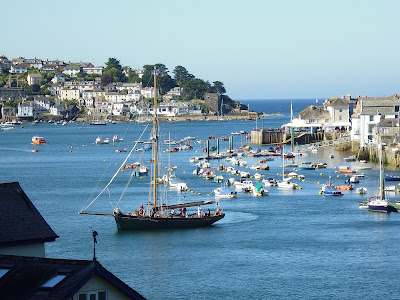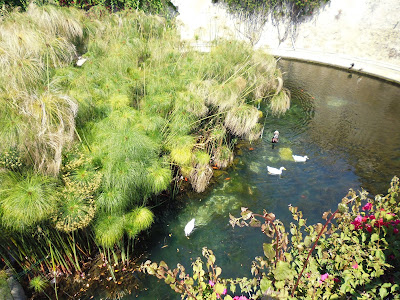The Nottingham tram network has been expanded – there are
three lines now – and although the building has been absolutely agony, with
roads closed for months and monumental traffic jams, and shopkeepers along the
route nearly suicidal, the end result, I think, is excellent. Of course, being
a city resident and old, I don’t pay,
and this probably sways my judgement. They have thought to put a
park and ride car park at each end of all the lines, and one line is highly
convenient for my daughter’s house, and that convinces me that it’s really well
planned.
But what I’ve been particularly enjoying has been spotting
the names of the trams. It’s kind of a crash course (not literally, thank
goodness) on the history of Nottingham
people, and who is considered worthy of having a tram named after them.
Of course, there’s a Robin Hood, but there are a number of
writers, which is quite appropriate since Nottingham has just become a UNESCO City
of Literature. I have no idea why Nottingham, more than other cities, or what
it means for the future, but it’s kind of nice. Anyway, the writers who have
trams named after them are Lord Byron, Alan Sillitoe and D.H. Lawrence. None of
the still living Nottingham writers have been honoured with a tram. Perhaps
there’s a worry that they’ll go out of fashion. I really like Jon McGregor, but
he wasn’t born in Nottingham. However neither was Byron.
There’s also a tram called after a successful
screenwriter, William Ivory, formerly a Nottingham dustman, and one for Stephen Lowe
the playwright and director. And while we’re on the stage, there’s a Vicky
McClure, named for the actor. She was a member of the Childrens’ Television Workshop, along with Samantha
Morton, Jack O’ Connell, Joe Dempsie , and many other successful actors. Oldest
son went there – he loved it, and also made quite a bit of cash from doing bit parts in TV dramas, although he ended up
being an accountant.
Then there are scientists. There’s an Ada Lovelace; she was Lord Byron’s daughter
and a pioneer of computing (I did actually understand Bernoulli numbers when I
took a little historical walk which included her grave, but as soon as I didn’t
need to understand them, they went.)
George Green has a
tram and an engineering building at the university named after him – he was a
largely self taught mathematical genius,
and you can visit the windmill in
Sneinton where he was the miller, and which
has been restored. The storage buildings on the site have been turned into a
little science education centre. As a lot of his work is on electricity and
magnetism, there are lots of fun things to do. It’s quite a good place to take
children.
Another scientist with a tram is Sir Peter Mansfield, who
developed the MRI scanner. He failed his eleven plus exam and failed to get into
grammar school, which just shows how rubbish the system was, and how stupid it
is for those Conservative idiots to want to bring back grammar schools. Not
that grammar schools have gone away entirely. They are popular with parents who
are sure their children will pass the exam and then won’t have to mix with the
riff raff. Personally I think learning to cope with all sorts of people is an
important part of education.
There are trams named
after quite a lot of different sporting
types. There’s Brian Clough, manager of the Nottingham Forest side who won the
European cup two years in succession, and Viv Anderson who was the first black
footballer to play for England. There is a tram called Torvill and Dean, after
the Nottingham Ice dancers who scored perfect tens at the Sarajevo Olympics.
Why they didn’t get a tram each, goodness knows. Although they did move in perfect unison ha
ha.
There are two boxers - Carl Froch, the world super middleweight champion, and one named Bendigo after the all England bare knuckle
champion. He was one of triplets who were named (naturally) Shadrach, Mesach
and Abednego, and therefore became famous as Bendigo; and had a serious drink problem in later
life. I don’t think he can have been punchdrunk, as bare knuckle boxers
couldn’t hit as hard. It would simply break their hand. But some of his fights
went on for over a hundred rounds, which I shouldn’t imagine does your head
much good. Anyway, later still, he stopped drinking, got religion and became a
lay preacher. So a happy ending of sorts. Bendigo in Australia is named after an Australian fighter who was named after the Nottingham Bendigo.
Sid Standard is also a sporting hero, but he isn’t famous
for winning, but for getting kids into cycling. So really a more worthwhile
hero than many others. And David Clarke of Nottingham Panthers ice hockey team
has a tram.
The latest sporting hero is Stuart Broad, who took 8 wickets
for sixteen runs in the Ashes here in Nottingham at Trent Bridge last summer.
Actually, it was a bad thing for Nottingham in some ways, because all the
people who’d travelled to Nottingham to see the match went home. Instead of
five days it lasted two and a bit, so the city must have lost money on it. But
I can’t tell you how satisfying it was to see the Australians collapse. A tram was immediately selected as the
perfect tribute to a wonderful display of bowling, and to everyone’s joy at
thrashing the Aussies.
One tram is named William Booth, after the founder of the
Salvation Army, born in 1829 in Sneinton, Nottingham. There are lots of local
people you won’t have heard of, but who have trams named after them as a
tribute to their charitable work, which is a really nice thank you to them. One is named after a
lady who has volunteered for Homestart, which provides support for struggling
families, and when the Nottingham Evening Post asked for nominations for people
to have trams named for them, the family she has supported for years
immediately nominated her. And some are
named for nurses and midwives who won nurse of the year awards.
A very important
businessman commemorated with a tram is Jesse Boot, founder of Boots the
Chemist, still a big employer in the city, and an important city benefactor,
helping to get the university started and giving it a great deal of land.
Then there’s the tram called George Africanus. He ran
various businesses in Nottingham, including a servants’ registry. He was brought
to Britain from Sierra Leone as a slave
in 1766, when he was about three, but died in 1834, a well known and prosperous
businessman. And there’s Sat Bains, who
runs a Michelin starred restaurant. I
haven’t been there - whenever I suggest a posh restaurant, Phil says he won’t
pay that when he eats better at home.
Huh. Flattery. And stinginess. Still, he's lovely really.










































